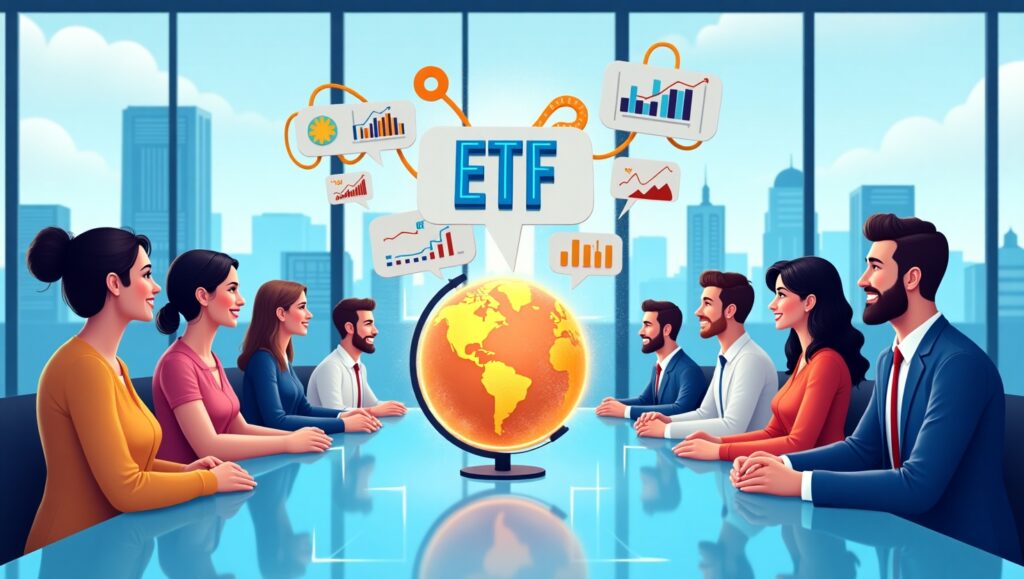Disclaimer: The following article is for informational purposes only and does not constitute financial advice. Investing involves risk, including the possible loss of principal. Please consult with a qualified financial advisor before making any investment decisions.
Related Reading: Understanding Mutual Funds vs. ETFs: Key Differences for Beginners
Quick Guide to ETFs
Before diving into the details, here’s what you need to know about ETFs:
- ETF stands for Exchange-Traded Fund, a basket of securities that trades on exchanges like individual stocks
- Offers instant diversification across various assets including stocks, bonds, and commodities
- Generally lower expense ratios than mutual funds (average ETF expense ratio: 0.16% compared to 0.57% for mutual funds)
- Provides flexibility with trading throughout the day at market prices
- Tax-efficient structure minimizes capital gains distributions in most cases
- Suitable for both beginners and experienced investors seeking diversification with lower costs
Understanding ETFs: The Basics
Exchange-Traded Funds (ETFs) have revolutionized investing since their introduction in the early 1990s. Initially, they were designed to track major stock indexes, but over time, they’ve evolved to cover virtually every asset class, sector, and investment strategy imaginable.
In essence, an ETF is a collection of securities—such as stocks, bonds, or commodities—that you can buy and sell through a brokerage firm on a stock exchange. Think of an ETF as a basket containing many different investments bundled together, which you can purchase with a single transaction.
According to the Investment Company Institute, ETF assets totaled approximately $7.2 trillion in the United States at the end of 2023, demonstrating their massive popularity and growth. In fact, BlackRock’s research shows that ETF adoption has grown globally over the past decade.
How ETFs Work
Unlike mutual funds that trade once per day after the market closes, ETFs trade throughout the day like stocks, with continuously updating prices. This provides greater flexibility for investors who want to react quickly to market changes.
The structure of ETFs is also distinctive. Authorized participants (typically large financial institutions) create or redeem ETF shares directly with the fund. This creation/redemption mechanism helps keep an ETF’s market price closely aligned with its underlying net asset value (NAV).
Moreover, most ETFs are designed to track specific indexes (such as the S&P 500 or the NASDAQ-100), aiming to replicate the performance of those benchmarks rather than outperform them. This passive investment approach is one reason why ETFs generally have lower management fees than actively managed funds.
Types of ETFs: Finding the Right Fit
The ETF universe has expanded dramatically, offering investors numerous options to align with their specific goals and risk tolerance. Understanding the major types of ETFs can help you determine which might best suit your investment strategy.
Stock (Equity) ETFs
Stock ETFs remain the most popular category of all ETF assets according to data from ETFGI, a leading ETF research firm. Within this category, you’ll find several subtypes:
- Broad market ETFs: Track major indexes like the S&P 500 (e.g., VOO, SPY) or total stock markets
- Sector ETFs: Focus on specific industries such as technology (XLK), healthcare (XLV), or energy (XLE)
- Growth and value ETFs: Target stocks with particular characteristics like growth potential or value attributes
- Dividend ETFs: Concentrate on companies with histories of paying stable or growing dividends
- Market capitalization ETFs: Focus on large-cap, mid-cap, or small-cap companies
Bond ETFs
For investors seeking income or stability, bond ETFs offer exposure to fixed-income securities while providing more liquidity than individual bonds. Options include:
- Government bond ETFs: Invest in U.S. Treasury securities with varying maturities
- Corporate bond ETFs: Hold bonds issued by corporations, typically sorted by credit quality
- Municipal bond ETFs: Contain tax-advantaged bonds issued by state and local governments
- International bond ETFs: Provide exposure to foreign government and corporate debt
Specialty ETFs
Beyond traditional stocks and bonds, specialty ETFs offer exposure to alternative investments:
- Commodity ETFs: Provide access to physical commodities like gold (GLD), silver, or agricultural products
- Real estate ETFs: Invest in real estate investment trusts (REITs) and property companies
- Currency ETFs: Track the value of foreign currencies relative to the U.S. dollar
- Inverse and leveraged ETFs: Designed to deliver the opposite return (inverse) or a multiplied return (leveraged) of their underlying index
According to J.P. Morgan Asset Management, thematic and ESG (Environmental, Social, and Governance) ETFs have seen the fastest growth in recent years, with assets increasing between 2019 and 2023.
Benefits of Investing in ETFs
ETFs have gained tremendous popularity for good reasons. Here are the key advantages that make them appealing to investors of all experience levels.
Diversification at Lower Cost
Perhaps the most significant benefit of ETFs is instant diversification. With a single purchase, you gain exposure to dozens, hundreds, or even thousands of individual securities. This diversification helps reduce risk by spreading your investment across multiple companies, sectors, or asset classes.
Furthermore, ETFs typically come with lower costs than mutual funds. According to Morningstar’s 2023 fee study, the asset-weighted average expense ratio for ETFs was 0.16%, compared to 0.57% for mutual funds. This cost difference may seem small, but it can significantly impact long-term returns.
Trading Flexibility and Transparency
Unlike mutual funds, ETFs trade throughout the day on exchanges, allowing investors to buy and sell shares at current market prices rather than end-of-day net asset values. This flexibility can be particularly valuable during volatile market periods.
Additionally, most ETFs disclose their holdings daily, providing full transparency about what you own. In contrast, mutual funds typically report their holdings quarterly, with a delay.
Tax Efficiency
ETFs generally distribute fewer capital gains to investors than mutual funds, making them more tax-efficient for taxable accounts. This advantage stems from their unique structure and the in-kind creation/redemption process.
Research from Vanguard indicates that ETF investors can save an average of 0.38% annually in after-tax returns compared to similar mutual funds due to this tax efficiency.
Accessibility and Minimum Investment
ETFs are accessible to investors with varying budget constraints. You can purchase as little as one share of an ETF (or even fractional shares through many brokerages), making them ideal for beginners starting with limited capital. Many brokerages now offer commission-free ETF trading, further reducing the barrier to entry.
Potential Drawbacks of ETFs
Despite their numerous advantages, ETFs aren’t without drawbacks. Understanding these potential downsides is essential for making informed investment decisions.
Trading Costs and Premiums/Discounts
While many brokerages offer commission-free ETF trading, investors should be aware of the bid-ask spread—the difference between the highest price a buyer is willing to pay and the lowest price a seller is willing to accept. For less liquid ETFs, these spreads can be wider, increasing the effective cost of trading.
Additionally, ETFs can sometimes trade at prices slightly above (premium) or below (discount) their net asset value. According to research from the Federal Reserve Bank of New York, these discrepancies typically remain small for mainstream ETFs but can become significant during market stress.
Not All ETFs Are Low-Cost
While many ETFs feature low expense ratios, specialized or actively managed ETFs can carry higher fees. Some thematic or niche ETFs charge expense ratios exceeding 0.75%, substantially higher than broad-market index ETFs. Always check the expense ratio before investing in an ETF.
Over-Concentration Risks
Some sector or thematic ETFs may be heavily concentrated in a few companies, potentially increasing risk. For instance, technology-focused ETFs often have substantial allocations to giants like Apple, Microsoft, and Amazon. This concentration can lead to unexpected volatility if these key holdings underperform.
Too Many Choices
With over 3,000 ETFs available in the U.S. alone, according to ETF.com, the abundance of choices can overwhelm investors, particularly beginners. This phenomenon, known as “choice overload,” can lead to decision paralysis or suboptimal investment selections.
How to Start Investing in ETFs
Getting started with ETF investing doesn’t need to be complicated. Follow these steps to build an ETF portfolio aligned with your financial goals.
Assess Your Goals and Risk Tolerance
Before selecting specific ETFs, clarify your investment objectives and time horizon. Are you investing for retirement decades away, saving for a home down payment in five years, or building an emergency fund? Your goals will influence which ETFs are most appropriate for your portfolio.
Similarly, honestly evaluate your risk tolerance—your emotional and financial ability to withstand market fluctuations. If market downturns cause you significant stress or you’ll need the money soon, a more conservative ETF allocation may be suitable.
Choose a Brokerage Account
To purchase ETFs, you’ll need a brokerage account. Most major online brokerages offer commission-free ETF trading, but compare other features:
- User-friendly interface and educational resources
- Account minimum requirements
- Available research tools and ETF screeners
- Customer service quality
- Additional fees (account maintenance, inactivity fees, etc.)
Popular brokerages for ETF investors include Vanguard, Fidelity, Charles Schwab, and newer platforms like Robinhood and M1 Finance. According to J.D. Power’s 2023 U.S. Self-Directed Investor Satisfaction Study, Fidelity ranked highest in overall investor satisfaction.
Build a Diversified ETF Portfolio
For beginners, starting with a simple portfolio of broad-market ETFs provides immediate diversification across asset classes:
- U.S. stock market ETF (e.g., VTI, ITOT, SCHB)
- International stock ETF (e.g., VXUS, IXUS)
- Bond ETF (e.g., BND, AGG)
A common starting point is the “three-fund portfolio,” which includes these three components. The specific allocation depends on your risk tolerance and time horizon. Generally, younger investors with longer time horizons might allocate more to stocks (80-90%), while those approaching retirement might increase their bond allocation for stability.
Implement a Consistent Investment Strategy
Two popular approaches for investing in ETFs are:
- Lump-sum investing: Investing available funds all at once
- Dollar-cost averaging: Regularly investing a fixed amount, regardless of market conditions
For most long-term investors, Vanguard research suggests that lump-sum investing has historically outperformed dollar-cost averaging about two-thirds of the time. However, dollar-cost averaging can be psychologically easier and helps establish good investing habits.
ETFs vs. Other Investment Options
Understanding how ETFs compare with alternative investment vehicles helps determine their appropriate role in your portfolio.
ETFs vs. Mutual Funds
While ETFs and mutual funds both offer diversified exposure to various asset classes, key differences include:
| Feature | ETFs | Mutual Funds |
|---|---|---|
| Trading | Throughout trading day | Once daily after market close |
| Minimum Investment | One share (or less with fractional shares) | Often $1,000-$3,000 |
| Expense Ratios | Average 0.16% | Average 0.57% |
| Tax Efficiency | Generally more tax-efficient | May distribute more capital gains |
| Active vs. Passive | Mostly passive, some active | Many active options |
According to Charles Schwab’s 2023 ETF Investor Study, 91% of investors who use both ETFs and mutual funds prefer ETFs for their lower costs, while 80% favor them for tax efficiency.
ETFs vs. Individual Stocks
Compared to individual stocks, ETFs offer:
- Broader diversification: Reducing company-specific risk
- Lower research requirements: No need to analyze individual companies
- Often lower volatility: Less dramatic price swings than individual stocks
However, individual stocks may provide:
- Greater control over specific holdings
- Potentially higher returns for successful stock pickers
- No management fees (though trading commissions may apply)
ETFs vs. Index Funds
Index mutual funds and index ETFs both track market benchmarks, but ETFs typically offer:
- Intraday trading capability
- Potentially greater tax efficiency
- Often lower investment minimums
The performance difference between comparable index ETFs and index mutual funds is typically minimal after accounting for fees, making the choice largely about structural preferences rather than expected returns.
FAQs About ETF Investing
Are ETFs safe for beginners?
ETFs are generally considered appropriate for beginning investors due to their diversification, transparency, and typically lower costs. However, “safety” depends on the specific ETF’s underlying investments. A broad-market stock ETF will fluctuate with market conditions, while a Treasury bond ETF offers more stability but lower long-term growth potential. Beginners should start with broadly diversified, low-cost ETFs aligned with their risk tolerance and time horizon.
How many ETFs should I own?
For most investors, especially beginners, 3-5 well-chosen ETFs can provide sufficient diversification across asset classes and geographies. Adding too many ETFs can lead to overlapping holdings, unnecessary complexity, and potentially higher costs. Focus on covering major asset classes (U.S. stocks, international stocks, bonds) before considering specialized ETFs for specific sectors or themes.
Do ETFs pay dividends?
Many ETFs do pay dividends, distributing the dividend income received from their underlying holdings to ETF shareholders. Most ETFs that hold dividend-paying stocks pay dividends quarterly, while bond ETFs typically distribute income monthly. Investors can choose to receive these dividends as cash or reinvest them to purchase additional ETF shares. Dividend-focused ETFs specifically target companies with histories of consistent or growing dividend payments.
What’s the difference between active and passive ETFs?
Passive ETFs track specific indexes by holding the same securities in the same proportions as their benchmark index. They aim to match the index’s performance, not beat it. Active ETFs, conversely, have portfolio managers who select investments trying to outperform a benchmark. Active ETFs typically have higher expense ratios (averaging 0.69% according to Morningstar) than passive ETFs (averaging 0.16%). While active management offers the potential for outperformance, research shows that the majority of active funds underperform their benchmarks over long periods.
Can I lose all my money investing in ETFs?
While it’s theoretically possible to lose your entire investment in certain specialized ETFs (like those using leverage or investing in volatile sectors), broadly diversified ETFs make total loss extremely unlikely. A total market stock ETF would only go to zero if essentially every public company in the market simultaneously failed—an implausible scenario. However, ETFs can definitely decline in value, sometimes significantly during market downturns. The S&P 500, for instance, fell approximately 34% during the initial COVID-19 crash in early 2020 before recovering. Understanding your ETF’s underlying holdings and risk profile is essential for assessing potential downside risk.
Conclusion
ETFs have democratized investing by offering diversification, flexibility, and lower costs than many traditional investment vehicles. For beginners and experienced investors alike, they provide an efficient way to build a diversified portfolio aligned with specific financial goals and risk tolerance.
When considering whether ETFs are right for you, focus on your investment objectives, time horizon, and comfort with various levels of risk. Start with broad-market, low-cost ETFs covering major asset classes before exploring more specialized options. Remember that even within the ETF universe, investment success typically comes from maintaining a long-term perspective, controlling costs, and avoiding emotional reactions to market fluctuations.
By understanding both the advantages and limitations of ETFs, you can make informed decisions about incorporating them into your investment strategy. Whether used as core portfolio holdings or tactical additions, ETFs offer valuable tools for navigating today’s complex financial markets.


